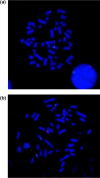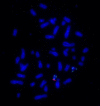Verification of a cryptic t(Y;15) translocation in a male with an apparent 45,X karyotype
- PMID: 35164811
- PMCID: PMC8842983
- DOI: 10.1186/s13039-022-00581-6
Verification of a cryptic t(Y;15) translocation in a male with an apparent 45,X karyotype
Abstract
Background: A rare disease is that an individual with a non-chimeric karyotype of 45,X develops into a male. We explored the genetic aetiology of an infertile male with an apparent 45,X karyotype, which was subsequently verified as cryptic translocation between chromosomes Y and 15.
Methods: DNA was extracted from the patient's peripheral blood. A range of genetic testing was performed, including conventional chromosomal karyotyping, short tandem repeat (STR) analysis for azoospermia factor (AZF) region, fluorescence in situ hybridization (FISH) with specific probes groups of DXZ1/DYZ3, DYZ3/D15Z1/PML and SRY/D15Z1/PML, and chromosomal microarray analysis (CMA) for genomic copy number variations (CNVs).
Results: The patient was found to have an apparent 45,X karyotype. STR analysis showed that he possessed a short arm of the Y chromosome, including the SRY gene; however, he was missing the long arm of the Y chromosome, including AZFa + b + c and Yqter. A FISH assay of DXZ1 and DYZ3 probes showed a green signal of the X centromere and a red of the Y centromeric signal on a D-group-sized chromosome. By FISH assaying with D15Z1 and DYZ3 probes, chromosomes 15 and Y centromeric signals appeared closely on a single chromosome, as the PML control probe ascertained. A further FISH assay with D15Z1 and SRY probes revealed a signal of the SRY gene at the end of one arm of chromosome 15. The result of the CMA indicated a deletion with an approximate size of 45.31 Mb spanning from Yq11 to Yter.
Conclusion: Our study enriched the karyotype-phenotype correlation of Y and 15 chromosomes translocation. It strengthened the critical roles of molecular genetic techniques in identifying the chromosomal breakpoints and regions involved. Genetic aetiology can guide early intervention in childhood and assisted reproduction in adulthood.
Keywords: 45,X male; Azoospermia factor; Chromosomal microarray analysis; Fluorescence in situ hybridization; Sex-determining region Y gene; Y chromosome translocation.
© 2022. The Author(s).
Conflict of interest statement
The authors declare that they have no competing interests.
Figures







Similar articles
-
Pseudoautosomal abnormalities in terminal AZFb+c deletions are associated with isochromosomes Yp and may lead to abnormal growth and neuropsychiatric function.Hum Reprod. 2017 Feb;32(2):465-475. doi: 10.1093/humrep/dew333. Epub 2017 Jan 5. Hum Reprod. 2017. PMID: 28057878
-
Identification of an SRY-negative 46,XX infertility male with a heterozygous deletion downstream of SOX3 gene.Mol Cytogenet. 2022 Feb 14;15(1):2. doi: 10.1186/s13039-022-00580-7. Mol Cytogenet. 2022. PMID: 35164824 Free PMC article.
-
[Cytogenetic and molecular genetic analysis of a case with mosaic marker chromosomes].Zhonghua Yi Xue Yi Chuan Xue Za Zhi. 2016 Feb;33(1):76-80. doi: 10.3760/cma.j.issn.1003-9406.2016.01.019. Zhonghua Yi Xue Yi Chuan Xue Za Zhi. 2016. PMID: 26829740 Chinese.
-
Prenatal diagnosis of sex chromosome mosaicism with two marker chromosomes in three cell lines and a review of the literature.Mol Med Rep. 2019 Mar;19(3):1791-1796. doi: 10.3892/mmr.2018.9798. Epub 2018 Dec 24. Mol Med Rep. 2019. PMID: 30592288 Review.
-
Molecular detection of a translocation (Y;11) (q11.2;q24) in a 45,X male with signs of Jacobsen syndrome.Hum Genet. 1992 Mar;88(6):661-7. doi: 10.1007/BF02265294. Hum Genet. 1992. PMID: 1551671 Review.
Cited by
-
False-positive XXY results by interphase FISH in cytogenetically normal XX individuals: two cases highlighting the necessity of additional laboratory follow-up.Mol Cytogenet. 2024 Nov 13;17(1):27. doi: 10.1186/s13039-024-00697-x. Mol Cytogenet. 2024. PMID: 39533353 Free PMC article.
References
-
- Bilen S, Okten A, Karaguzel G, Ikbal M, Aslan Y. A 45 X male patient with 7q distal deletion and rearrangement with SRY gene translocation: a case report. Genet Couns. 2013;24(3):299–305. - PubMed
LinkOut - more resources
Full Text Sources
Miscellaneous

